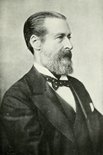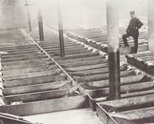
In his continuing series charting a course to, for all its faults, the kinder world we live in today, Michael Denham, past President of the BGS and currently our archivist, features another great philanthropist, Lord Rowton.
In the latter decades of the Victorian era the population in London was increasing rapidly, reaching 6.5 million in 1901. This expansion caused housing problems and inspired George Peabody, a London based American banker, to setup a housing association in 1862, which built large housing estates in London, better known as Peabody Buildings, which would have been familiar to those of us who worked in London.
The Peabody initiative left unsolved the problem of homeless men, those looking for work away from their homes, vagrants and the ‘down and outs’ in London. Where were they to find overnight accommodation? Doss houses or squalid common lodging houses were available but their quality, even in the 1950s in Northern Ireland, could vary from reasonable to dreadful. Workhouse casual wards were another option but physical work was required ‘as payment’. The Salvation Army operated shelters for the homeless. Their amenities varied with how much a man could afford. At the cheap end was the ‘penny sit-up’ which provided food and shelter for a penny with the use of a bench all night, but the occupant was not allowed to sleep. The more expensive ‘two penny hangover’ was like the ‘penny sit-up’ except that there a rope was placed in front of the bench and the client was allowed to sleep as he hung over the rope but he was not allowed to lie down flat on his back and go to sleep. The rope was cut at daybreak to encourage clients to wake up early and leave: this arrangement achieved a mention in an episode of Hancock’s Half Hour. For four pennies, a man could stay in a ‘coffin box’. In addition to food he was allowed to lie down flat on his back and sleep in a coffin shaped wooden box with a tarpaulin for covering. Clients with more money could purchase a bed for the night. The ultimate alternative was to sleep rough, perhaps under the bridges over the Thames.

All this changed in 1890 when a chain of hostels, Rowton Houses, was built to provide accommodation for working men with vastly improved rooms, cubicles, washing facilities and dining arrangements. They were mentioned in an episode of the Goon Show.
Lord Rowton
The initiative came from a Victorian philanthropist, Lord Rowton, DL, PC, (1838 – 1903), who trained as a lawyer and later was Benjamin Disraeli’s long serving private secretary. He never married, although he was alleged to have had an affair with Violet, Marchioness of Granby. He died from pneumonia at his home in Berkeley Square in November 1903 at the age of 65.
In November 1889 he accepted the invitation of Sir Edward Cecil Guinness, to become a trustee of the Guinness Trust Fund with £250,000 for the provision of artisans' dwellings in London and Dublin. Rowton examined the living conditions in the poor districts of London and was dismayed by the unhealthy and squalid character of the common lodging-houses. Accordingly he developed the concept of a men's hostel, where cubicles, tiled wash rooms with hot and cold water, footbaths, washing troughs, drying facilities, large dining room, a library and clean sheets on the beds would be offered at the lowest price. Unfortunately this lay outside the scope of the Guinness Trust.
Rowton Houses
Lord Rowton devoted £30,000 (equivalent to over £3 million in present day money) of his own resources to build his concept of appropriate accommodation. A site was found in Bond Street, Vauxhall with a building designed by Sir Richard Farrant, whose company had experience in providing dwellings for the poor. Lord Rowton made himself responsible for every detail and even took one of the proposed beds home to test it. This initial design was followed in all subsequent Rowton Houses. The ground floor and basement contained the entrance hallway, dining room, smoking lounge, reading room, washrooms, barber's shop, shoemaker's and tailor's rooms, clothes and boot cleaning rooms, parcels room etc. The upper floors contained large numbers of private cubicles each of which contained a bed, chair, shelf, and a chamber pot. Residence cost 6d per day although no access to the cubicles was permitted during the daytime. Lodgers could either buy food in the dining-hall or cook their own food. Card games were banned but chess and draughts were available. The gate was closed at 9.30 am and opened at 7.15 pm for early morning workers, such as those working at Smithfield Meat Market.
The Vauxhall house, with accommodation for 447 persons, opened on 31st December 1892. There were initial teething troubles with a high turnover of staff and chaotic administration until a Superintendent was appointed. Every book in the house's library disappeared, resulting in the installation of lockable bookcases under the charge of a paid librarian, while at the first fire-drill it was discovered that every copper coupling and nozzle from the fire hoses had disappeared. Soap was no longer provided free after it was used in prodigious quantities. As word got around of the luxury provided for 6p a night, the occupancy rate rapidly increased from 77 on the first night. Because the facilities were of such a standard, Rowton Houses became officially categorised as ‘hotels’ and therefore escaped the compulsory inspection that applied to common lodging houses.
The first ‘Rowton House’ was followed by the establishment of a company, Rowton Houses Limited, in March 1894 with a subscribed capital of £75,000, of which £30,000 in shares was allotted to Lord Rowton in return for the money he had advanced. Lord Rowton was chairman, with Sir Richard Farrant, Mr. Cecil Ashley and Mr. Walter Long, M.P., as directors. The capital was subsequently raised to £450,000.
George Orwell stayed in a Rowton house as he recounted in 1933 : ‘The best [lodging houses] are the Rowton Houses, where the charge is a shilling, for which you get a cubicle to yourself, and the use of excellent bathrooms. You can also pay half a crown for a 'special', which is practically hotel accommodation. The Rowton Houses are splendid buildings, and the only objection to them is the strict discipline, with rules against cooking, card-playing, etc. Perhaps the best advertisement for the Rowton Houses is the fact that they are always full to overflowing’.
In all, six homes were built in London:
- Vauxhall, 1892,
- King’s Cross, 1894 (John Christie, the murderer, stayed here for four nights shortly before his arrest),
- Newington Butts, 1897,
- Hammersmith, 1897,
- Whitechapel, 1902, (Joseph Stalin stayed here for two weeks in 1907),
- Arlington House, Camden Town, 1905, which is the only house still in use as a hostel.

The general concept proved popular and was copied in Liverpool, Birmingham (now converted to a hotel), Newcastle upon Tyne and Milan.
After the First World War the houses were modernized with electric light and old open fires replaced by central heating. The lodgers' own kitchens, were removed although tea-making facilities were retained. During the Second World War, the Houses were used as refugee accommodation or air-raid shelters. Afterwards they were increasingly occupied by the elderly with modest means for whom they offered a more attractive residence than other types of institutional home — one King’s Cross resident lived in the House for 22 years. Some residents did seasonal work elsewhere during the spring and summer then returned to spend the autumn and winter in London.
The King's Cross Rowton House continued in operation until 1960, by which time prices had risen to 3s.6d per night for a simple cubicle, to 4s.6d - 7s. per night for more comfortable bedrooms. Over its life it had provided over 20 million bookings. After a £300,000 refit, it re-opened on October 9th 1961 as the Mount Pleasant Hotel with 340 single and 82 double rooms, each equipped with a radio and telephone. A single room with bed and breakfast now cost 21 shillings or 35 shillings for full board.
Rowton Houses no longer exist but the problems for which they were built persist. The various definitions of ‘homeless’ make it difficult to formulate an accurate number but one estimate of those sleeping rough in London in 2013 put the figure at 6,500.